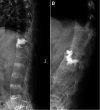Kyphoplasty for thoracic and lumbar fractures with an intravertebral vacuum phenomenon in ankylosing spondylitis patients
- PMID: 35965876
- PMCID: PMC9372763
- DOI: 10.3389/fsurg.2022.962723
Kyphoplasty for thoracic and lumbar fractures with an intravertebral vacuum phenomenon in ankylosing spondylitis patients
Abstract
Background: Intravertebral vacuum phenomenon (IVP) is a special sign after vertebral fractures, which is common in patients with ankylosing spondylitis (AS) and may indicate pseudarthrosis and bone nonunion that lead to spinal instability. The objective of this study is to evaluate the efficacy and safety of kyphoplasty (KP) in treating such types of vertebral fractures with AS.
Methods: Sixteen patients with AS suffering from thoracic or lumbar fractures with IVP received KP from 2015 to 2020 and were monitored for more than 1 year. The visual analog scale (VAS) score was used to evaluate back pain relief. The Oswestry Disability Index (ODI) questionnaire was used to assess the improvement of the patients' living quality. The anterior and middle vertebral height restoration ratio (AVH, MVH) and the kyphotic angle (KA) were used to evaluate the radiographic results.
Results: The mean follow-up period was 20.8 months (12-28 months). The VAS and ODI significantly reduced at 3 days, 3 months after surgery, and at the last follow-up compared with the preoperative outcomes (p < 0.05). The AVH and MVH were significantly increased compared with the preoperative outcomes (p < 0.05). There was a significant correction in the KA between pre- and postoperative assessments (p < 0.05). Asymptomatic intradiscal polymethylmethacrylate (PMMA) cement leakage was found in two patients.
Conclusions: For thoracic or lumbar fractures with IVP in AS patients, KP may be safe and effective, which achieves pain relief and satisfying functional improvement, restores the anterior and middle height, and corrects the kyphotic angle of the fractured vertebra.
Keywords: PMMA; ankylosing spondylitis; intravertebral vacuum phenomenon; kyphoplasty; vertebral fracture.
© 2022 Liu, Zhou, Zhang, Deng, Hu, He, Liu and Yang.
Conflict of interest statement
The authors declare that the research was conducted in the absence of any commercial or financial relationships that could be construed as a potential conflict of interest.
Figures





Similar articles
-
Balloon kyphoplasty: an evidence-based analysis.Ont Health Technol Assess Ser. 2004;4(12):1-45. Epub 2004 Dec 1. Ont Health Technol Assess Ser. 2004. PMID: 23074451 Free PMC article.
-
[COMPARISON OF EFFECTIVENESS BETWEEN PERCUTANEOUS VERTEBROPLASTY AND PERCUTANEOUS KYPHOPLASTY FOR TREATMENT OF OSTEOPOROTIC VERTEBRAL COMPRESSION FRACTURE WITH INTRAVERTEBRAL VACUUM CLEFT].Zhongguo Xiu Fu Chong Jian Wai Ke Za Zhi. 2016 Sep 8;30(9):1104-1110. doi: 10.7507/1002-1892.20160225. Zhongguo Xiu Fu Chong Jian Wai Ke Za Zhi. 2016. PMID: 29786364 Chinese.
-
High viscosity bone cement vertebroplasty versus low viscosity bone cement vertebroplasty in the treatment of mid-high thoracic vertebral compression fractures.Spine J. 2022 Apr;22(4):524-534. doi: 10.1016/j.spinee.2021.12.013. Epub 2021 Dec 24. Spine J. 2022. PMID: 34958934
-
Comparison of Percutaneous Vertebroplasty and Balloon Kyphoplasty for the Treatment of Single Level Vertebral Compression Fractures: A Meta-analysis of the Literature.Pain Physician. 2015 May-Jun;18(3):209-22. Pain Physician. 2015. PMID: 26000665 Review.
-
Is Osteoporotic Thoracolumbar Burst Fracture a Contraindication to Percutaneous Kyphoplasty? A Systematic Review.Pain Physician. 2021 Sep;24(6):E685-E692. Pain Physician. 2021. PMID: 34554685
Cited by
-
Analysis of factors influencing the intravertebral shell phenomenon after posterior reduction internal fixation of thoracolumbar fracture: a retrospective study.BMC Musculoskelet Disord. 2024 Jan 10;25(1):49. doi: 10.1186/s12891-024-07168-9. BMC Musculoskelet Disord. 2024. PMID: 38200488 Free PMC article.
-
Percutaneous kyphoplasty with or without posterior pedicle screw fixation for the management of severe osteoporotic vertebral compression fractures with nonunion.J Orthop Surg Res. 2024 Apr 15;19(1):240. doi: 10.1186/s13018-024-04714-y. J Orthop Surg Res. 2024. PMID: 38622736 Free PMC article.
-
Management of Thoracolumbar Vertebral Fractures and Dislocations in Patients with Ankylosing Conditions of the Spine.Orthop Rev (Pavia). 2024 Mar 1;16:94279. doi: 10.52965/001c.94279. eCollection 2024. Orthop Rev (Pavia). 2024. PMID: 38435438 Free PMC article.
References
LinkOut - more resources
Full Text Sources
Research Materials

